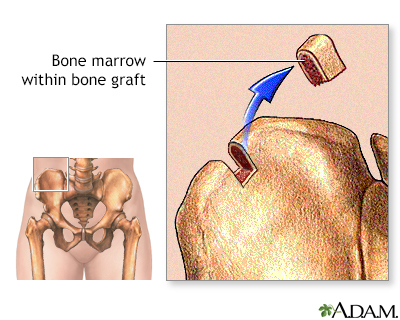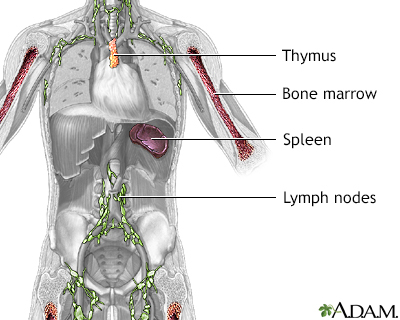Definition
Acute lymphoblastic leukemia (ALL) is a fast-growing cancer of a type of white blood cell called a lymphoblast.
ALL occurs when the bone marrow produces a large number of immature lymphoblasts. Bone marrow is the soft tissue in the center of bones that helps form all blood cells. The abnormal lymphoblasts grow quickly and replace normal cells in the bone marrow. ALL prevents healthy blood cells from being made. Life-threatening symptoms can occur as normal blood counts drop.
Alternative Names
ALL; Acute lymphoblastic leukemia; Acute lymphoid leukemia; Acute childhood leukemia; Cancer - acute childhood leukemia (ALL); Leukemia - acute childhood (ALL); Acute lymphocytic leukemia
Causes
Most of the time, no clear cause can be found for ALL.
The following factors may play a role in the development of all types of leukemia:
- Certain chromosome problems
- Exposure to radiation, including x-rays before birth
- Past treatment with chemotherapy drugs
- Receiving a bone marrow transplant
- Toxins, such as benzene
The following factors are known to increase the risk for ALL:
- Down syndrome or other genetic disorders
- A brother or sister with leukemia
This type of leukemia usually affects children ages 3 to 7. ALL is the most common childhood cancer, but it can also occur in adults.
Symptoms
ALL makes a person more likely to bleed and develop infections. Symptoms include:
- Bone and joint pain
- Easy bruising and bleeding (such as bleeding gums, skin bleeding, nosebleeds, abnormal periods)
- Feeling weak or tired
- Fever
- Loss of appetite and weight loss
- Paleness
- Pain or feeling of fullness below the ribs from an enlarged liver or spleen
- Pinpoint red spots on the skin (petechiae)
- Swollen lymph nodes in the neck, under arms, and groin
- Night sweats
These symptoms can occur with other conditions. Talk to a health care provider about the meaning of specific symptoms.
Exams and Tests
The provider will perform a physical exam and ask about your symptoms.
Blood tests may include:
Tests are also done to look for changes in the DNA inside the abnormal white cells. Certain DNA changes may determine how well a person does (prognosis), and what kind of treatment is recommended.
Treatment
The first goal of treatment is to get blood counts back to normal. If this occurs and the bone marrow looks healthy under the microscope, the cancer is said to be in remission.
Chemotherapy is the first treatment tried with the goal of achieving a remission.
- The person may need to stay in the hospital for chemotherapy. Or it can be given at a clinic and the person goes home afterward.
- Chemotherapy is given into the veins (by IV) and sometimes into the fluid around the brain (the spinal fluid).
After a remission is achieved, more treatment is given to achieve a cure. This treatment can include more IV chemotherapy or radiation to the brain. Stem cell or bone marrow transplant from another person may also be done. Further treatment depends on:
- Age and health of the person
- Genetic changes in the leukemia cells
- How many courses of chemotherapy it took to achieve remission
- If abnormal cell DNA is detected in the bone marrow after remission
- Availability of donors for stem cell transplant
You and your provider may need to manage other concerns during your leukemia treatment, including:
Support Groups
You can ease the stress of illness by joining a cancer support group. Sharing with others who have common experiences and problems can help you not feel alone.
Outlook (Prognosis)
Those who respond to treatment right away tend to do better. Most children with ALL can be cured. Children often have a better outcome than adults.
Possible Complications
Both leukemia itself and the treatment can lead to many problems such as bleeding, weight loss, and infections.
When to Contact a Medical Professional
Contact your provider if you or your child develops symptoms of ALL.
Prevention
The risk for developing ALL may be reduced by avoiding contact with certain toxins, radiation, and chemicals.
References
National Cancer Institute website. Adult acute lymphoblastic leukemia treatment (PDQ) - health professional version. www.cancer.gov/types/leukemia/hp/adult-all-treatment-pdq. Updated January 18, 2022. Accessed June 27, 2022.
National Cancer Institute website. Childhood acute lymphoblastic leukemia treatment (PDQ) - health professional version. www.cancer.gov/types/leukemia/hp/child-all-treatment-pdq. Updated April 6, 2022. Accessed June 27, 2022.
Pillai PM, Carroll WL. Acute lymphoblastic leukemia. In: Fish JD, Lipton JM, Lanzkowsky P, eds. Lanzkowsky's Manual of Pediatric Hematology and Oncology. 7th ed. Philadelphia, PA: Elsevier; 2022:chap 18.






